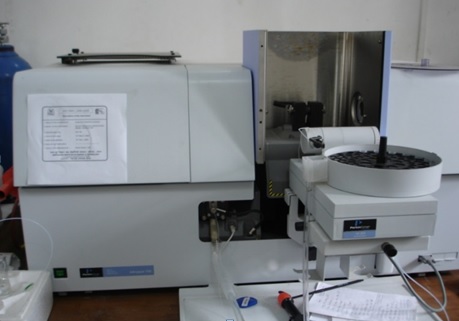





Sophisticated Analytical Instruments Facility
| Name of the equipment/facility: Atomic Absorption Spectrometer |  |
| Make: Perkin Elmer | |
| Model: AAnalyst -700 | |
| Specification: | |
Specification: AAnalyst-700 is equipped with three modes namely HGA furnace, flame and cold vapour generating flow injection FIAS system. It can detect metals in PPM and PPB levels.
Optical System: Real-time, double-beam optical system with protectively-coated, front-surfaced, reflecting optics. Optical system sealed within protective cover.
Monochromator: Littrow design with motorized drive for automatic wavelength selection and peaking.
Wavelength range: 190 - 900 nm
Diffraction grating: 1800 lines/mm blazed at 236 nm and 597 nm
Grating area: 64 x 72 mm
Reciprocal linear dispersion: 1.6 nm/mm (nominal)
Focal length: 267 mm
Spectral bandwidths: 0.2, 0.7 and 2.0 nm, dual height; motorized slit drive
Detector: Segmented solid-state detector, including a built-in low-noise CMOS charge amplifier array.
Automatic Lamp Selection: 8-lamp holder with built-in power supplies for hollow cathode and electrodeless discharge lamps. Computer-controlled lamp selection and alignment via WinLab32™ software. Operating parameters are automatically set when using PerkinElmer Lumina™ hollow cathode lamps.
Atomizers: (a) Flame atomization (b) Electro thermal atomization
Gas: Argon, Acetylene.
|
|
| Applications: | |
| The system is an integrated combination having Flame as well as Graphite furnace technologies for elemental (trace & heavy metals) analysis.
Atomic-absorption (AA) spectroscopy uses the absorption of light to measure the concentration of gas-phase atoms. Since samples are usually liquids or solids, the analyte atoms or ions must be vaporized in a flame or graphite furnace. The atoms absorb ultraviolet or visible light and make transitions to higher electronic energy levels. The analyte concentration is determined from the amount of absorption. Concentration measurements are usually determined from a working curve after calibrating the instrument with standards of known concentration. A working curve is the plot of the analytical signal (absorbance) as a function of analyte concentrations. The working curve is prepared by measuring signal (absorbance) from a series of standard of known concentrations. The working curve is then used to measure the concentration of the unknown samples.
Beer-Lambert law: The Beer-Lambert law (or Beer's law) is the linear relationship between absorbance and concentration of an absorbing species. The general Beer-Lambert law is usually written as:
A = a(λ) * b * c
Where, A is the measured absorbance, a(λ) is a wavelength-dependent absorptivity coefficient, b is the path length, and c is the analyte concentration.
Also it is attached with FLOW Injection Analysis System (FIAS-100) which is useful for the analysis of hydride forming elements such as: As, Se, Sb and Hg, Heavy metal estimation in both PPM and PPB levels, Plant and fruit extract analysis for metal estimation, Drill cut, drill mud and Pit water from oil field analysis for metal estimation.
|
|
| User Instructions: | |
(a) External Users( Other than CSIR): same as for internal
(b) Internal Users :
(1) For liquid samples (strictly prohibited use of HF): Required 15 ml for per element. Samples should be cleared. Detection limits up to ppb.
(2) For solid samples: Sample should be dried and powder form. It has to be digested before metal analysis. Required amount approx. 500 mg per sample. Detection limit up to ppb.
|
|
| Contact | |
| Ms Ankana Phukan, Technical Officer, ankana@neist.res.in, 8876532776 | |
| Charges (Excluding Taxes) | |
Charges (Excluding Taxes): (a) For National Labs( R&D) : Rs. 500 (element/sample) + Sample preparation: Rs. 500/- extra (c) University/Educational Institutes : Rs. 500 (element/sample) + Sample preparation: Rs. 500/- extra
|
|